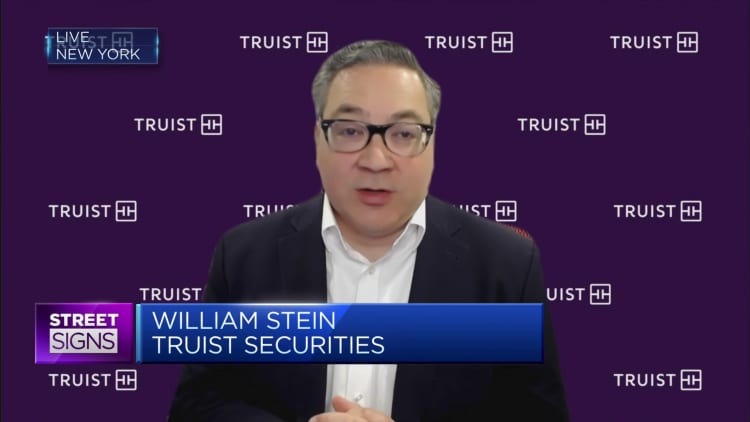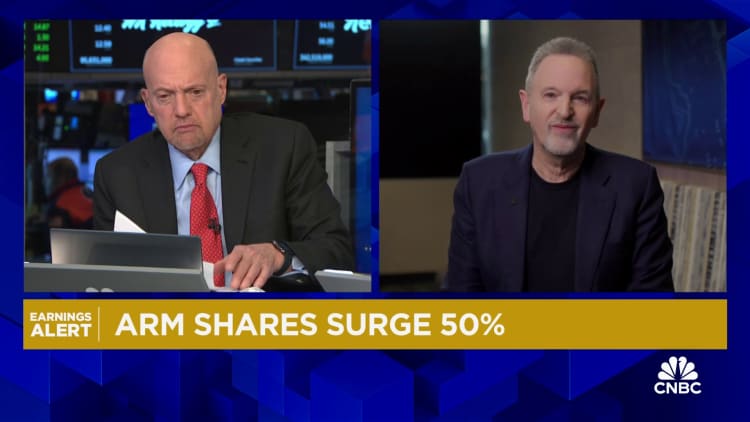The logo of semiconductor design firm Arm on a chip.
Jakub Porzycki | Nurphoto | Getty Images
Exactly two years ago, Nvidia’s attempt to purchase chip designer Arm from SoftBank came to an end due to “significant regulatory challenges.”
Masayoshi Son, SoftBank’s billionaire founder, has never been so lucky.
That agreement would have involved selling Arm for $40 billion, or just $8 billion more than SoftBank paid in 2016. Instead, Arm went public last year, and the company is now worth over $116 billion after the stock soared 48% on Thursday.
SoftBank still owns roughly 90% of the outstanding stock, meaning its stake in Arm increased by more than $34 billion in a day.
But the rally is somewhat confounding when looking at how the market values Arm. Wall Street may start to get a clearer sense of how much investors are willing to pay next month, when the 180-day lockup period expires and SoftBank will have its first opportunity to sell.

Chipmakers Nvidia and AMD have been Wall Street darlings of late due to their central position in the artificial intelligence boom. Nvidia makes the bulk of the processors used for cutting-edge AI models like those that power ChatGPT, while large tech companies have also indicated their interest in purchasing competitive chips from AMD as they hit the market.
But Arm is now being valued at a much higher earnings multiple than either of those companies. As of Thursday’s close, investors are valuing Arm at close to 90 times forward earnings. That compares with a forward price-earnings ratio of 33 for Nvidia and 46 for AMD, which both have significantly higher multiples than other major chip stocks like Intel and Qualcomm.
In reporting better-than-expected quarterly results Wednesday, Arm gave investors some new data to suggest that its growth rate could persist through the next fiscal year. Arm said it was breaking into new markets thanks to AI demand, and that its primary market, smartphone technology, was recovering from a slump.
‘Gain market share’
Arm has a different business model than Nvidia and AMD in that it’s largely a technology licensing company. Arm said its royalties business, in which billions of chips manufactured each quarter result in a small fee to use the company’s architecture, was surprisingly strong. That’s because it can charge twice as much for its latest instruction set, called Arm v9, which accounted for 15% of the company’s royalties.
“Arm continues to gain market share in the growth markets of cloud servers and automotive which drive new streams of royalty growth,” the company said in its investor letter.
Arm’s revenue forecast for the current quarter points to 38% annual growth at the midpoint of the range, marking a significant acceleration from recent periods. But for Nvidia, analysts are expecting growth of more than 200% for the January quarter and almost that level the next period.
AMD has been growing much slower and is expected to remain in the single digits until the back half of the year, when expansion is expected to accelerate.
Lisa Su, president and CEO of AMD, talks about the AMD EPYC processor during a keynote address at the 2019 CES in Las Vegas, Nevada, U.S., January 9, 2019.
Steve Marcus | Reuters
While Arm has some AI chip development, its technology is oriented around the central processor, or CPU. AI chips are often graphics processors, or GPUs, which use a different approach to running multiple calculations at the same time.
Still, Arm says it stands to benefit from AI chips. CEO Rene Haas mentioned Nvidia’s Grace Hopper 200 chip, which will start shipping in finished systems in April, on a call with analysts. That chip combines one of Nvidia’s GPUs — an H100 — with a CPU that uses Arm’s Neoverse design.
“The drivers and direction of travel for Arm are as outlined at the time of its IPO, but the timing and slope is sooner and steeper due to AI.” wrote Citi analyst Andrew Gardiner in a note Thursday. “Given we are in the very early innings of AI adoption, we expect Arm’s sales trends to remain robust into FY25/26.”
The company said its backlog of expected licensing sales rose 42% on an annual basis to $2.4 billion.
For Son and SoftBank, the fortuitous scuttling of the Nvidia-Arm deal means an opportunity for the Japanese conglomerate to directly benefit from the growth in AI and the premium that Wall Street is placing on chip companies at the center of the action.
SoftBank on Thursday said its Vision Fund investment group logged a $4 billion gain in the latest quarter, after a brutal stretch of losses from bad bets like WeWork. SoftBank said in the December quarter that it booked an investment gain of $5.5 billion thanks to the Arm IPO.
If the stock can hold at these levels or even keep going up, more gains are in store.
“Arm is the biggest contributor to the global AI evolution,” SoftBank finance chief Yoshimitsu Goto said during an earnings presentation Thursday. He even went so far as to call SoftBank’s investment pool an “AI-centric portfolio.”
— CNBC’s Arjun Kharpal contributed to this report.
Correction: Rene Haas is CEO of Arm. An earlier version misspelled his name.
WATCH: CNBC’s full interview with Arm CEO Rene Haas

Don’t miss these stories from CNBC PRO:
Credit: Source link














